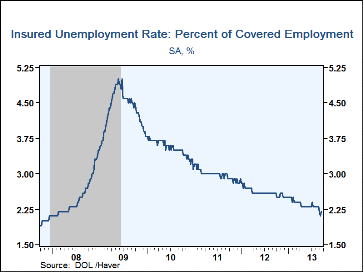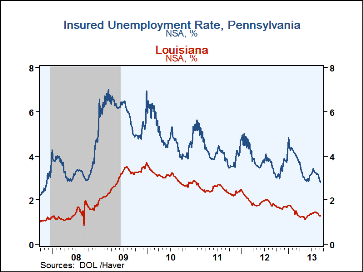 Global| Sep 26 2013
Global| Sep 26 2013U.S. Initial Claims for Jobless Benefits Unexpectedly Move Lower
by:Tom Moeller
|in:Economy in Brief
Summary
Labor market improvement is continuing in full swing. Initial claims for unemployment insurance fell to 305,000 during the week ended September 21 from 310,000 in the prior week, revised from 309,000. Expectations had been for an [...]
Labor market improvement is continuing in full swing. Initial claims for unemployment insurance fell to 305,000 during the week ended September 21 from 310,000 in the prior week, revised from 309,000. Expectations had been for an increase to 325,000 according to the Action Economics Forecast Survey. The four-week moving average of initial claims fell sharply to 308,000, its lowest level since June 2007. Data processing problems in California and Nevada were resolved.
Continuing claims for unemployment insurance in the week ended September 14 declined to 2.823 million (-13.8% y/y) from 2.788 million a week earlier. The four-week moving average of continuing claims fell to a cycle-low of 2.843 million. The insured rate of unemployment ticked up to 2.2%. This particular count covers only "regular" programs and does not include all extended benefit and other specialized jobless insurance programs. In the week of September 7, the latest figure available, the total of all benefit recipients inched up to 3.921 million (-24.2% y/y). This broader measure is not seasonally adjusted. It compares to a cycle peak of 12.060 million in January 2010 and pre-recession figures that averaged 2.596 million for 2007. The number of individuals who were collecting emergency and extended payments in the week of September 7 rose slightly to 1.349 million (-37.6% y/y).
By state, the insured rate of unemployment continued to vary greatly with North Dakota (0.41%), Virginia (1.12%), Louisiana (1.31%), Ohio (1.38%), Maine (1.44%), Indiana (1.45%) and Texas (1.52%) at the low end of the range. At the high end were Michigan (1.78%), Wisconsin (2.08%), California (2.09%), Illinois (2.51%), New York (2.63%), Pennsylvania (2.83%) and New Jersey (3.41%).
Data on weekly unemployment insurance are contained in Haver's WEEKLY database and they are summarized monthly in USECON. Data for individual states are in REGIONW. The consensus estimates come from the Action Economics survey, carried in the AS1REPNA database.
| Unemployment Insurance (000s) | 09/21/13 | 09/14/13 | 09/07/13 | Y/Y % | 2012 | 2011 | 2010 |
|---|---|---|---|---|---|---|---|
| Initial Claims | 305 | 310 | 294 | -16.9 | 375 | 409 | 459 |
| Continuing Claims | -- | 2,823 | 2,788 | -13.8 | 3,318 | 3,744 | 4,544 |
| Insured Unemployment Rate (%) | -- | 2.2 | 2.1 | 2.6 (9/12) |
2.6 | 3.0 | 3.6 |
| Total "All Programs" (NSA) | -- | -- | 3.921 mil. | -24.2 | 6.047 mil. | 7.750 mil. | 9.850 mil. |
Tom Moeller
AuthorMore in Author Profile »Prior to joining Haver Analytics in 2000, Mr. Moeller worked as the Economist at Chancellor Capital Management from 1985 to 1999. There, he developed comprehensive economic forecasts and interpreted economic data for equity and fixed income portfolio managers. Also at Chancellor, Mr. Moeller worked as an equity analyst and was responsible for researching and rating companies in the economically sensitive automobile and housing industries for investment in Chancellor’s equity portfolio. Prior to joining Chancellor, Mr. Moeller was an Economist at Citibank from 1979 to 1984. He also analyzed pricing behavior in the metals industry for the Council on Wage and Price Stability in Washington, D.C. In 1999, Mr. Moeller received the award for most accurate forecast from the Forecasters' Club of New York. From 1990 to 1992 he was President of the New York Association for Business Economists. Mr. Moeller earned an M.B.A. in Finance from Fordham University, where he graduated in 1987. He holds a Bachelor of Arts in Economics from George Washington University.










